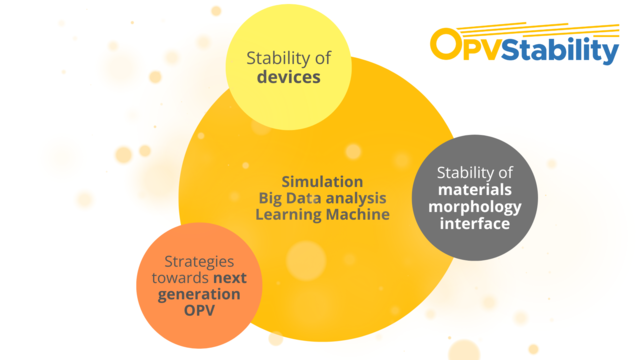Workpackages

OPV stability has identified four major objectives that four scientific work packages will address to achieve the overall research goal.
WP1: Stability of Devices
The first objective is an in-depth analysis of the key ageing parameters on the lifetime of OPV devices, including high-throughput screening, accelerated ageing tests and detailed device characterisation.
Expected results:
- Fast identification of suitable material combinations and determination of the major degradation triggers.
- Cluster materials and architectures in degradation trends with the aim, then, to select the most stable materials and model system.
Partners involved:
TU Graz -Technical University Graz, AT - Coordinator;
BGU - Ben-Gurion University of the Negev, IL
KAU - Karlstad University, SWE
FAU - Friedrich-Alexander Univerisity, Erlangen - Nürnberg, DE
WP2: Stability of Materials, Morphology & Interfaces
The project will also investigate the intrinsic stability of organic semiconductors and degradation pathways of materials, interfaces and absorber layer’s morphology by systematic studies and advanced analytics at the nanoscale to fully understand degradation caused by the interactions of all components in a solar cell and to unveil hidden degradation triggers. This is combined with theoretical modelling and chemical space sampling to identify stable and weak structural components in OPV absorber materials.
Expected results:
- Identify intrinsic stable structural motifs and deep understanding of degradation pathways.
Partners involved:
TU Graz -Technical University Graz, AT - Coordinator;
JKU Linz - Johannes Kepler University Linz, AT
KAU - Karlstad University, SWE
CERIC-ERIC Central Euruopean Research Infrastructure Consortium European Research, IT
WP3: Strategies towards Next Generation OPV
Thirdly, the project will develop strategies to improve OPV stability. Based on the results from objectives 1 and 2, devices with the most promising materials will be further optimized by applying additional stabilisation strategies. In particular, long-lasting OPV devices will be enabled via the modification of interfaces and the addition of biomimetic antioxidants.
Expected results:
- OPV devices with a prolonged lifetime of more than five years and a fivefold increase in accumulated energy generation.
Partners involved:
TU Graz -Technical University Graz, AT - Coordinator;
JKU Linz - Johannes Kepler University Linz, AT
KAU - Karlstad University, SWE
ICMAB-CSIC Agencia Estatal Consejo Superior de Investigaciones Cientificas, ES
SDU - University of Southern Denmark or Syddansk Universitet , DK
CERIC-ERIC Central Euruopean Research Infrastructure Consortium European Research, IT
WP4: Simulation , BIg Data Analysis, Machine Learning
Finally, the project will implement these approaches to analyse data generated via high-throughput experiments to identify stable materials and develop predictive models for new organic materials and next-generation OPV devices. This will lead to more data that can be routinely screened and analysed. Additionally, a method for predicting the lifetime of OPV based on time-zero characteristics will be developed.
Expected results:
- Statistically highly significant results due to advanced data analysis and simulation methods.
- Prediction of new stable OPV materials.
- Novel tools for reliable classification of OPV devices regarding their expected lifetimes based on time-zero characteristics.
Partners involved:
FAU - Friedrich-Alexander Univerisity, Erlangen - Nürnberg, DE
CERIC-ERIC Central Euruopean Research Infrastructure Consortium European Research, IT

